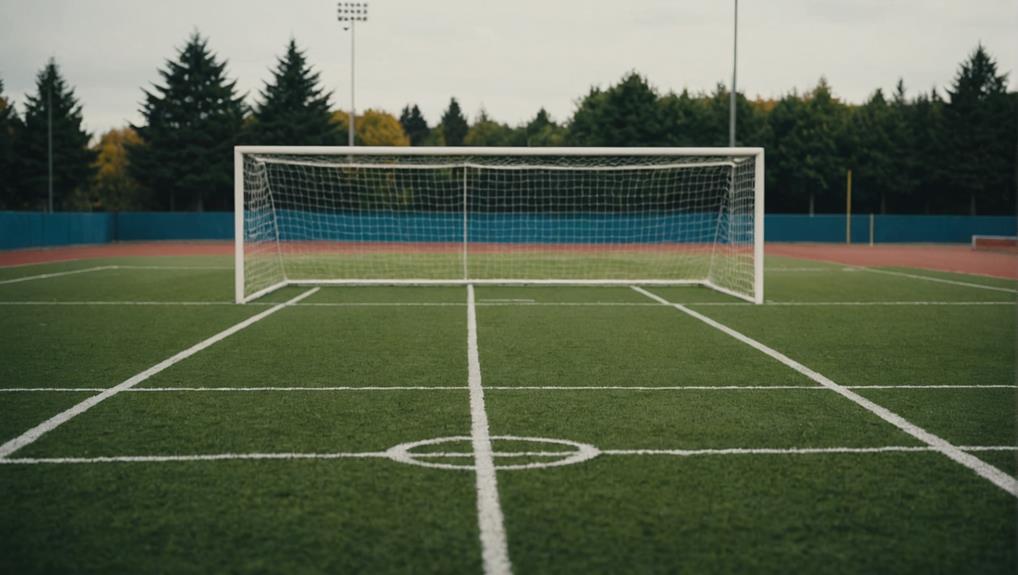
What Is the Soccer Goal Area? Explained
July 12, 2024In soccer, the goal area is an essential rectangular space that extends 6 yards from the goal posts onto the field. It serves as the scene for important game moments such as goal kicks and setting up defensive plays. Understanding this area is vital for mastering offensive and defensive strategies on the soccer field. If you grasp the ins and outs of the goal area, you'll uncover the tactical advantages it offers to both goalkeepers and the team in possession, enhancing your comprehension of the game's dynamics.
Definition of Soccer Goal Area
The definition of the soccer goal area, also known as the six-yard box, is essential for understanding key aspects of gameplay near the goal. This rectangular zone extends 6 yards from each goal post and 6 yards into the pitch, forming part of the larger penalty area.
Within this space, goal kicks originate, and the defending team can take free kicks. The goal area is vital for goalkeepers, allowing them to use their hands and take charge of the defense during set pieces. It's also the designated area for certain rules like indirect free kicks, dropped balls, and regulating charging offenses by goalkeepers.
The goal lines delimit this zone, and players must maneuver skillfully inside the penalty area to score goals. Understanding the purpose and regulations of the goal area is fundamental for players, referees, and fans to grasp the intricacies of soccer gameplay.
Dimensions and Boundaries
Understanding the layout of the soccer goal area, also referred to as the six-yard box, requires knowledge of its specific dimensions and boundaries.
The goal area extends 6 yards from each goal post into the field and is a rectangular area in front of the goal, measuring 6 yards by 20.44 yards. Goalkeepers have the advantage of being able to handle the ball with their hands within this area, giving them more control over defending the goal. Additionally, goal kicks are taken from inside the goal area, providing a strategic advantage for the team in possession.
For defending teams, the goal area plays a pivotal role in organizing defensive strategies.
It serves as a designated space where defenders can position themselves to protect the goal effectively. By understanding the boundaries and dimensions of the goal area, defending teams can create a solid defensive line and make it challenging for the opposing team to score penalties or close-range goals.
Role of Goalkeeper

Within the soccer goal area, the goalkeeper's role is pivotal in organizing defensive strategies and preventing goals. As the only player allowed to use their hands within the goal area, goalkeepers must master ball handling techniques and adhere to specific rules for distribution. Their primary focus is on keeping the ball out of their net, making important saves to protect their team's goal.
Additionally, goalkeepers play a significant role in initiating attacks, providing assists, and supporting set-piece strategies from within the goal area. To stand out on the field, goalkeepers wear distinct uniforms that set them apart from other players. Furthermore, they receive protection from certain fouls within the goal area, ensuring their safety while performing their duties.
Essentially, the goalkeeper serves as the last line of defense, often being the deciding factor in a team's success or failure in a match.
Penalty Spot Importance
In penalty kick situations, the placement of the penalty spot plays a vital role in determining the outcome of the shot. The penalty spot, situated 12 yards from the goal line and in line with the center of the goal, marks the spot for penalty kicks, providing the kicker with a direct shot at the goal.
During penalty kicks, goalkeepers must remain on the goal line until the ball is struck, positioning themselves strategically to react to the shot. The penalty spot becomes the center of attention in high-pressure situations, as it often decides the outcome of games.
Only the goalkeeper and the penalty taker are permitted in the penalty area during a penalty kick, intensifying the focus on this pivotal spot on the pitch. The precision and composure demonstrated at the penalty spot can tip the balance in favor of either team, making it a critical element in soccer matches.
Offensive Strategies

Teams often employ various offensive strategies to break through the opponent's defense and create scoring opportunities in soccer matches. When focusing on offensive plays within the goal area, attacking players prioritize getting the ball into the opponent's penalty area to increase their goal-scoring chances.
Inside the penalty area is where a significant percentage of goals in professional football are scored, emphasizing the importance of strategic positioning and quick decision-making. To maximize scoring opportunities, teams often engage in physical battles and tactical maneuvers to outmaneuver the defense and create openings for shots on goal.
During set-piece situations, such as corner kicks or free kicks near the penalty area, players aim to exploit weaknesses in the opposition's defense and capitalize on any lapses to score critical goals. By mastering offensive strategies within the penalty area, teams can enhance their chances of securing pivotal victories in competitive soccer matches.
Conclusion
So, now that you know all about the soccer goal area, are you ready to step onto the field and put your knowledge to the test?
Remember, the goal area isn't just a space on the field, it's a key strategic element that can make or break a game.
Keep practicing, keep honing your skills, and who knows – maybe you'll be the next star goalkeeper or striker to dominate the goal area.


